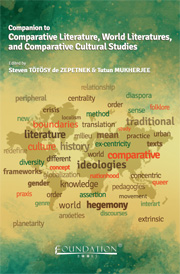Book contents
- Frontmatter
- Contents
- Introduction to the Companion to Comparative Literature, World Literatures, and Comparative Cultural Studies
- PART 1 Theories of Comparative Literature, World Literatures, and Comparative Cultural Studies
- PART 2 Comparative Literature in World Languages
- PART 3 Examples of New Work in Comparative Literature, World Literatures, and Comparative Cultural Studies
- African Literatures and Cultures and the Universal of Motherhood
- World literatures and the Case of Joyce, Rao, and Borges
- Abject Spaces and the Hinterland in Bolaño's Work
- The Motif of Fleeing in Gao's Work
- Arab Fiction and Migration in the Work of Haqqi and Salih
- Sexual Identity and Translation in Prime-Stevenson's Work
- The Notion of Life in the Work of Agamben
- Aesthetics, Opera, and Alterity in Herzog's Work
- An Intermedial Reading of Paley's Sita Sings the Blues
- Painting and Representation in Teaching Balzac
- PART 4 Multilingual Bibliography of Books in Comparative Literature, World Literatures, and Comparative Cultural Studies
- Index
Arab Fiction and Migration in the Work of Haqqi and Salih
from PART 3 - Examples of New Work in Comparative Literature, World Literatures, and Comparative Cultural Studies
Published online by Cambridge University Press: 05 April 2014
- Frontmatter
- Contents
- Introduction to the Companion to Comparative Literature, World Literatures, and Comparative Cultural Studies
- PART 1 Theories of Comparative Literature, World Literatures, and Comparative Cultural Studies
- PART 2 Comparative Literature in World Languages
- PART 3 Examples of New Work in Comparative Literature, World Literatures, and Comparative Cultural Studies
- African Literatures and Cultures and the Universal of Motherhood
- World literatures and the Case of Joyce, Rao, and Borges
- Abject Spaces and the Hinterland in Bolaño's Work
- The Motif of Fleeing in Gao's Work
- Arab Fiction and Migration in the Work of Haqqi and Salih
- Sexual Identity and Translation in Prime-Stevenson's Work
- The Notion of Life in the Work of Agamben
- Aesthetics, Opera, and Alterity in Herzog's Work
- An Intermedial Reading of Paley's Sita Sings the Blues
- Painting and Representation in Teaching Balzac
- PART 4 Multilingual Bibliography of Books in Comparative Literature, World Literatures, and Comparative Cultural Studies
- Index
Summary
Abstract: In her article “Arab Fiction and Migration in the Work of Haqqi and Salih” Ikram Masmoudi proposes that twentieth-century Arab fiction is marked by the theme of the journey in literal and figurative ways. The Saint's Lamp by Yahya Haqqi and Season of Migration to the North by Tayeb Salih depict two different kinds of enigmatic arrivals. Their arrival is the opportunity to adjust and assess their positions and their cultural differences. Although the two arriving protagonists in these novels have different attitudes vis-à-vis the West and their local culture, the structure of arrival in both novels is not straightforward and immediate, but instead reflects a negotiation between two attitudes and a transition from an immediate, physical arrival to an inner, mental arrival. This leads to a new understanding of and an adjustment to a fuller sense of arrival.
In the middle of his life and experience as a writer living and writing in England, the main character and narrator of V. S. Naipaul's autobiographical novel The Enigma of Arrival, an Indian from colonial Trinidad retires to the English countryside to heal and reflect on a series of aspects of his life: his metropolitan encounters, his career, and his early attempts at writing. In the cottage he rents he stumbles upon a few books left there by pervious tenants. Among them was a booklet with reproductions of famous paintings.
- Type
- Chapter
- Information
- Companion to Comparative Literature, World Literatures, and Comparative Cultural Studies , pp. 423 - 433Publisher: Foundation BooksPrint publication year: 2014



